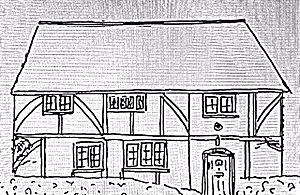Peasant homes in medieval England facts for kids
Imagine living in a home in medieval England! Peasant homes were usually simple, but very important. The hearth, or fireplace, was the heart of the home. It was used for cooking and keeping warm. Some bigger homes even had special rooms for making food, like bakehouses, and places to store crops, like barns. A fire was almost always burning, even at night, because it was hard to start a new one.
Contents
What Were Medieval Peasant Homes Like?
For a long time, many historians thought peasant houses were just simple huts. They believed these homes were small, often with only one or two rooms. People and animals might even live in the same space! It was also thought that these houses didn't last very long.
But new discoveries have changed this idea. Today, experts know that many medieval houses were built to last. Thousands of these homes from the later medieval period still exist! This shows that they were much stronger than once believed.
Who Were the Peasants?
The word "peasant" actually included many different kinds of people. By the 1400s, some peasants became quite wealthy. These richer peasants often lived in the countryside, especially in areas where farming was less common. For example, in Kent, there were many successful farmers called yeomen. Their homes, known as Wealden buildings, were very well-built.
In other parts of England, like the Midlands, houses were simpler. These homes often used a building style called cruck construction. This meant the roof and walls were held up by large, curved wooden beams. These simpler homes likely belonged to less wealthy peasants.
Common Features of Peasant Homes
Peasant homes in Southern England often had an open hall. This was a large main room. They usually did not have a chimney or an upstairs floor. You can tell this because of the soot (black dust from smoke) found from the central hearth.
Homes in places like Kent, Sussex, and East Anglia had special roof designs. They also had unique wooden beams and supports. Houses in these areas were often very good quality. This suggests they belonged to peasants who were doing quite well.
Midland houses were usually simpler. Many were "cruck houses," where big wooden timbers called "cruck blades" supported the roof and walls. Some also had "box-frame" houses, which used a strong wooden frame.
The Hearth and Kitchen
The hearth was the main cooking area. It could be very simple. People cooked on flat stones called bakestones or in pots. They would place pots directly on the fire. Sometimes, pots were hung over the fire or placed around its edges.
By the late 1300s, some homes used iron grates called branderths. Pots were placed on top of these grates. This was an early version of a modern cooking range. If people used coal instead of wood, the hearth would be built differently. Coal was a main fuel in some areas, like Derbyshire.
Even small peasant kitchens had many useful items. They had brass and earthenware (clay) pots and pans. They also had storage chests and large tubs. Richer homes had even more items, like extra linens and basins.
A clever invention was the pot lid for earthenware pots. These lids helped food cook better and faster. They also made flavors stronger! Earthenware pots were used for boiling water, cooking vegetables, and making meat stews. They were also used to prepare dairy products like cheese.
Brewing Ale at Home
While some people brewed beer for sale, many peasant families made their own ale at home. This was a common activity in the countryside. It was usually done on a small scale, just enough for the family.


